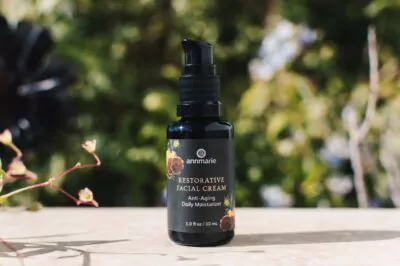Table of Contents[Hide][Show]
Chlorphenesin is another synthetic preservative found in cosmetics and personal care products. As far as synthetic preservatives go, it’s one of the milder ones. It’s not considered as toxic as parabens or iodopropynyl butylcarbamate—though it can cause dermatitis in adults—but like benzyl alcohol, it’s not safe for infants.
Moms, beware!
This preservative may cause slow or shallow breathing in your baby.
What is Chlorphenesin?
A synthetic chemical made in the laboratory, chlorphenesin has two main uses:
- Muscle relaxant: Used to treat muscle pain and spasms, it works by blocking nerve impulses traveling to the brain.
- Preservative: It has anti-fungal and antibacterial characteristics, and thus is used as a preservative in various cosmetics.
Manufacturers like to use chlorphenesin as a preservative because it prevents products from going through color changes, pH changes, emulsion breakdown, microorganism growth, and disagreeable odor formation. The ingredient is allowed at up to 0.3 percent in cosmetic products in the U.S. and Europe.
You’re likely to find this ingredient in hair products, moisturizers, sunscreens, anti-aging products, eye creams, toners/astringents, foundations, concealers, and mascaras. According to the Cosmetic Ingredient Review (CIR), the ingredient is used in over 1,300 products.
Is It Safe?
On May 23, 2008, the FDA issued a press release warning mothers not to use or purchase Mommy’s Bliss Nipple Cream because some of the ingredients may cause respiratory distress or vomiting and diarrhea in infants. The product is made to help nursing mothers heal dry or cracked nipples, and the label at the time stated there was no need to wash the product off before breastfeeding.
The cream contained chlorphenesin, however, which because of its muscle-relaxing properties, could potentially depress a baby’s nervous system and cause slow or shallow breathing. The cream also contained “phenoxyethanol,” which is another preservative that may cause vomiting and diarrhea, which can lead to dehydration in infants.
“The FDA is particularly concerned that nursing infants are being unwittingly exposed by their mothers to this product with dangerous side effects,” said Janet Woodcock, M.D., director, FDA’s Center for Drug Evaluation and Research. “Additionally, these two ingredients may interact with one another to further compound and increase the risk of respiratory depression in nursing infants.”
The FDA added that chlorphenesin can also harm the mother by causing dermatitis, a skin condition that can worsen the drying and cracking of nipple skin.
Not Too Bad, but Why Take the Risk?
Chlorphenesin has been reported to cause irritation and contact dermatitis in some people, particularly those with sensitive and dry skin. The Cosmetic Ingredient Review (CIR) expert panel released a safety assessment in October 2012, however, that stated chlorphenesin at 0.3 percent (as it exists in personal care products) was classified as having “negligible dermal irritation potential.” In other words, small amounts may be less concerning depending on your skin sensitivity.
In tests evaluating allergies to preservatives, however, chlorphenesin had a high irritancy rate for those allergic to preservatives. The panel also determined that the ingredient could increase sensory irritation in some creams, particularly when used together with parabens and phenoxyethanol. Overall, the panel concluded the ingredient was safe at current usage concentrations (0.3%).
Of course, as I’ve said many times, we don’t have to use harsh and potentially harmful synthetic preservatives to protect our products from contamination. Several natural ingredients like tea tree, lemon, and rosemary work just fine without the health risks. Plus, they have skin benefits to boot!
To avoid this ingredient, read labels, and stay away from the following:
- Chlorphenesin
- 3-(4-chlorophenoxy)-1,2-propanediol
- 1,2-propanediol,3-(4-chlorophenoxy)-
- p-chlorophenyl glyceryl ether
Did you ever use a nipple cream or other product with chlorphenesin? Please share your story.








Chlorphenesin is not the same as the muscle relaxant, Chlorphenesin Carbamate.
just a minor correction to the chlorphenesin article. The muscle relaxant is “chlorphenesin carbamate”, chlorphenesin itself does not have this effect and is used solely as a preservative.